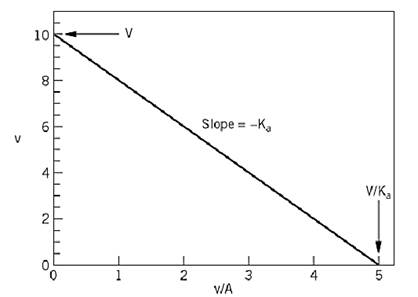Eadie–Hofstee Plot
The Eadie–Hofstee plot was developed by Eadie (1) and Hofstee (2) and is one of three graphical
procedures for determining values of the kinetic parameters for an enzyme-catalyzed reaction that conforms to Michaelis–Menten kinetics. It involves rearrangement of the initial velocity equation to a linear form that differs from that of the Lineweaver–Burk plot . The plot is derived from the Michaelis–Menten equation describing the dependence of the enzyme-catalyzed velocity v on the concentration of the substrate A and its Michaelis constant Ka; it is described by Equation (1):

where V is the maximum velocity of the reaction. Consequently, a plot of v against v/A yields a straight line with negative slope, equal to –Ka, a positive intercept on the abscissa that is equal to V/Ka, and a positive intercept on the vertical ordinate that is equal to V (Fig. 1).

Figure 1. Example of an Eadie–Hofstee plot for the determination of kinetic parameters for an enzyme-catalyzed reaction. The plot was produced by using the values of 10 and 2 (in arbitrary units) for V and Ka, respectively.
When values of V and Ka were being obtained by graphical methods, there were arguments for using this type of plot over that proposed by Lineweaver and Burk (3). But graphical procedures have now been supplanted by the use of regression analysis with computers (4. (
A graphical procedure is required for the presentation of kinetic data. However, results that are presented as the variation of a dependent variable as the function of the ratio of a dependent and an independent variable, as in the Eadie–Hofstee plot, are not as readily interpreted as those presented as the variation of a dependent variable with the concentration of an independent variable. Further, the form of the kinetic equations for multisubstrate enzyme reactions becomes unnecessarily complex with the Eadie–Hofstee plot.
References
1. G. S. Eadie (1942) J. Biol. Chem. 146, 85–93.
2. B. H. J. Hofstee (1959) Nature 184, 1296–1298.
3. J. E. Dowd and D. S. Riggs (1965) J. Biol. Chem. 240, 863–869.
4. W. W. Cleland (1979) Meth. Enzymol. 63, 103–138.
 الاكثر قراءة في مواضيع عامة في الاحياء الجزيئي
الاكثر قراءة في مواضيع عامة في الاحياء الجزيئي
 اخر الاخبار
اخر الاخبار
اخبار العتبة العباسية المقدسة


